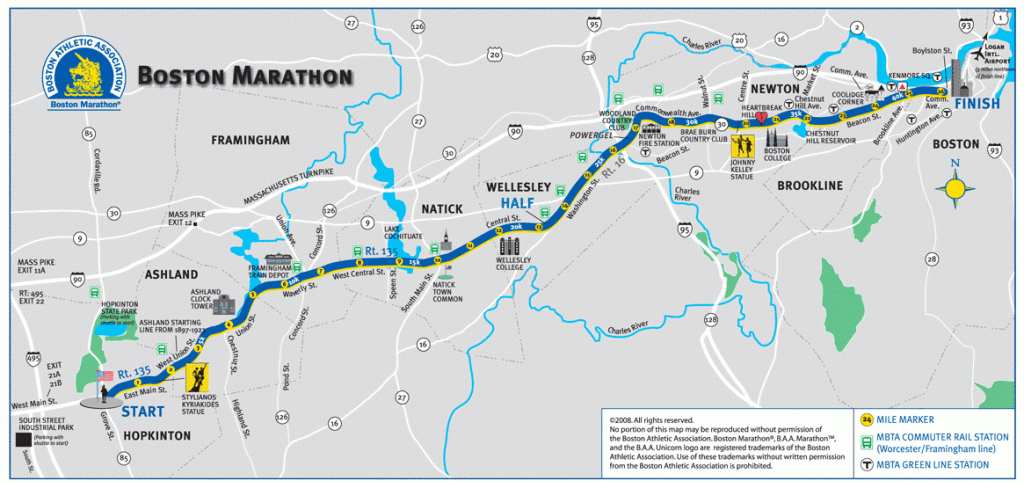The Boston Marathon Course - If you’re a runner, then you know of one of the most prestigious races in the world – the Boston Marathon. With its rich history dating back to 1897, the Boston Marathon is a bucket list race that every runner aspires to participate in at least once in their lifetime. The course itself is infamous for being challenging, with its rolling hills and unforgiving terrain. However, the reward for completing the race is invaluable. In this post, we’ll take a closer look at the Boston Marathon course, its history, and share some tips and ideas that will help runners conquer the race.
The Boston Marathon Course
The Boston Marathon is a 26.2 mile race that starts in Hopkinton, Massachusetts and ends in downtown Boston. The course itself passes through eight cities and towns, including Ashland, Framingham, Natick, Wellesley, Newton, Brookline, and, of course, Boston.
The course is known for its rolling hills, which can make for a challenging race. The first four miles of the course are relatively flat, but things quickly change as runners head into the town of Ashland. From there, the course gradually inclines until runners reach the infamous Heartbreak Hill, which is located just after the 20-mile mark. Heartbreak Hill is a half-mile incline that can be difficult for even the most seasoned of runners.
History of the Boston Marathon Course
The Boston Marathon course has a rich history that dates back over a century. The Boston Athletic Association first held the race in 1897, and the course itself has seen many changes over the years. In 1924, the course was altered so that the finish line would be located in front of the Boston Public Library – a tradition that is still carried out today.
One of the most significant changes to the course came in 1951, when the race was extended from 24.5 miles to the full 26.2 miles. This change was made to standardize the race distance for marathons worldwide. Another notable change to the course came in 1976, when the start line was moved from Ashland to Hopkinton.
Tips for Conquering the Boston Marathon Course
With its rolling hills and challenging terrain, the Boston Marathon course can be a difficult race to conquer. However, with the right preparation and mindset, runners can make the most of their experience. Here are some tips for conquering the Boston Marathon course:
Training
Training is the most essential part of preparing for any race, especially one as challenging as the Boston Marathon. Runners should aim to complete at least 16-20 weeks of consistent training before the race, including long runs, tempo runs, and hill workouts.
Fueling
Fueling is crucial during long-distance races, and the Boston Marathon is no exception. Runners should aim to consume 30-60 grams of carbohydrates per hour of running. It’s also essential to hydrate during the race, as dehydration can cause cramping and other issues.
Pace Yourself
With its rolling hills, it can be tempting to go out too fast in the early miles of the race. However, this can lead to burnout and fatigue later on. It’s crucial to pace yourself and save your energy for the later miles of the race, especially when you approach Heartbreak Hill.
Ideas for Making the Most of the Boston Marathon Experience
The Boston Marathon is more than just a race; it’s an experience that runners will remember for the rest of their lives. Here are some ideas for making the most of the Boston Marathon experience:
Spectating
If you’re not running in the race, there are still plenty of ways to experience the Boston Marathon. The course is lined with enthusiastic spectators, and there are many viewing spots where you can cheer on the runners. The most famous viewing spot is the historic Heartbreak Hill, which has become synonymous with the race itself.
Explore Boston
The Boston Marathon is an excellent opportunity to explore the city of Boston. From visiting historic sites like the Freedom Trail and the USS Constitution Museum to experiencing the city’s vibrant food and culture scene, there’s something for everyone in Boston.
Volunteering
If you’re not running in the race, volunteering is an excellent way to contribute to the Boston Marathon community. There are many opportunities to volunteer on race day, such as handing out water to runners or directing traffic along the course.
How to Register for the Boston Marathon
The Boston Marathon is one of the most popular races in the world, and getting into the race can be difficult. Here’s how to register for the Boston Marathon:
Qualify
One of the most common ways to get into the Boston Marathon is to qualify. To qualify, runners must run a certain time in a previous marathon, depending on their age and gender. For example, the qualifying time for men aged 18-34 is 3 hours and 5 minutes.
Charity Entry
If you are unable to qualify for the Boston Marathon, you can secure a spot through a charity entry. Many charities have spots reserved for runners who agree to raise a certain amount of money for their cause.
Invitational Entry
Invitational entries are reserved for elite runners and celebrities.
Whether you’re aiming to conquer the Boston Marathon course or just want to experience the race as a spectator or volunteer, there’s something for everyone in this historic event. With its challenging terrain, rich history, and vibrant community, the Boston Marathon is a bucket list race that every runner should aspire to participate in at least once in their lifetime.

:no_upscale()/cdn.vox-cdn.com/uploads/chorus_asset/file/8334767/coursemap_large.jpg)

:no_upscale()/cdn.vox-cdn.com/uploads/chorus_asset/file/6350215/Screen_Shot_2016-04-17_at_1.34.28_PM.0.png)
0 Response to "The Boston Marathon Course"
Post a Comment